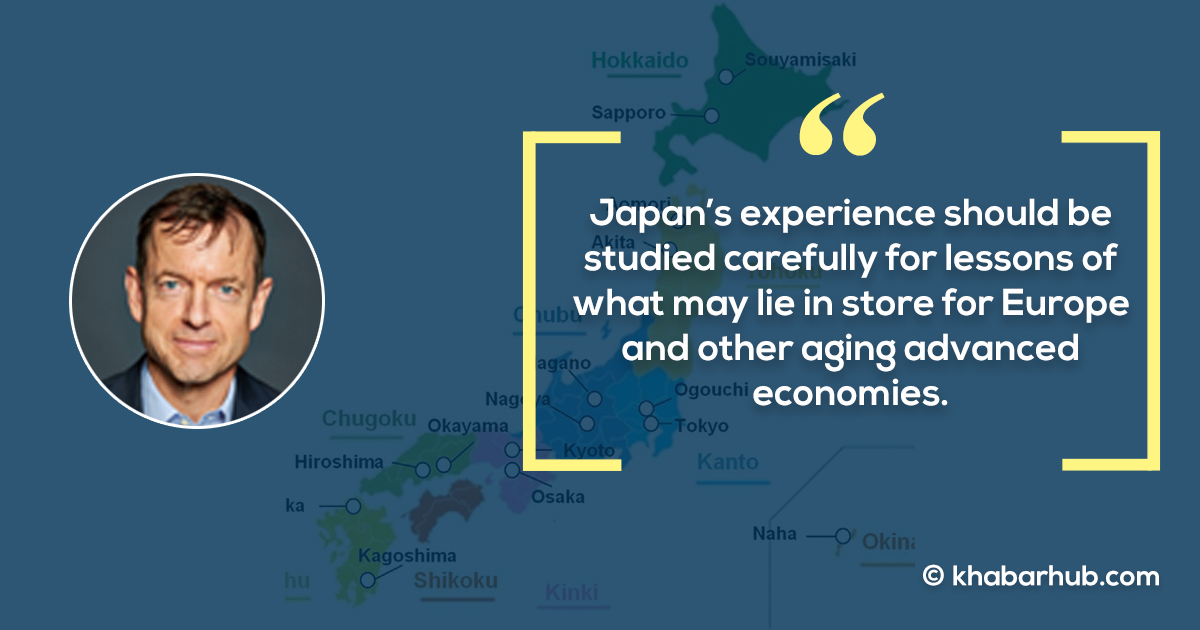The official reason given for Shinzo Abe’s departure as Japan’s longest-serving prime minister was personal health. And now, his signature economic-policy program may be headed for a similar fate.
“Abenomics” was ushered in with great fanfare in 2013, so it is worth considering what it has accomplished over the past seven years.
The official version on the Japanese government’s website has always featured three “policy arrows” targeted at aggressive monetary policy, flexible fiscal policy, and growth strategy, including structural reform.
Of these, monetary policy was clearly the biggest focus. The Bank of Japan (BOJ) launched a massive quantitative-easing (QE) program to buy up government debt, of which it now owns about half.
But while the official goal was to push up annual inflation to 2%, that target has yet to be reached.
At around 150%, Japan’s current net debt-to-GDP ratio will remain unchanged as long as the nominal GDP growth rate remains above 2% and the fiscal deficit is equal to or below 3% of GDP.
The low efficacy of QE was predictable from the outset, given that long-term interest rates were already low in early 2013, at around 0.6%.
Since 2016, they have fluctuated around zero. One might thus attribute to Abenomics’ monetary “arrow” a fall of 0.6 points, not enough to ignite inflation.
Some observers took the second arrow of Abenomics, “flexible fiscal policy,” to mean fiscal stimulus, while others foresaw fiscal consolidation. In the event, the policies pursued have mostly fallen into the latter category.
Just before Abe returned to power in December 2012, the fiscal deficit was over 8% of GDP; by 2016-19, it had been reduced to 3-4%.
This shift significantly slowed the growth of the country’s debt as a share of GDP.
At around 150%, Japan’s current net debt-to-GDP ratio will remain unchanged as long as the nominal GDP growth rate remains above 2% and the fiscal deficit is equal to or below 3% of GDP.
And now, the pandemic will have made it even harder to attain the canonical 2% inflation rate. In fact, the ECB may well be pursuing an impossible target for the foreseeable future.
One key achievement of Abenomics, then, is that it stabilized Japan’s public finances.
The third arrow comprised structural reforms that would spur economic growth by boosting the productivity of the existing labor force and increasing the number of workers.
On the matter of productivity gains, Abenomics was a total failure. Unlike in the eurozone, where labor productivity has at least inched up over the past seven years, Japan’s productivity has been essentially flat since 2010.
By contrast, there has been at least some progress on the size of the labor force.
But Japan had already achieved a high participation rate before Abenomics began, and the increases since then were in line with what one would have expected anyway.
With only small increases in labor force participation and almost no improvement in productivity, Japanese income growth under Abenomics has remained as low as it was before, averaging less than 1% per year.
For a short while, a strong rebound after tax hikes induced a recession in 2014 was seen as proof of Abenomics’ success.
But the recovery was aided by a strong gain in the country’s terms of trade, owing to the falling price of liquid natural gas, which Japan needed to import in greater quantities following the 2011 Fukushima nuclear disaster.
This one-time boost was hardly enough to launch a new era of sustained stronger growth.
Japan’s experience should be studied carefully for lessons of what may lie in store for Europe and other aging advanced economies.
One key lesson from Japan’s experience is that it is exceedingly difficult to generate inflation in an aging society with excess savings and abundant capital.
In 2014, core inflation fell briefly below 1% in the eurozone. The European Central Bank then started its own large asset-purchase program. But after years of buying, inflation barely rose above 1%.
And now, the pandemic will have made it even harder to attain the canonical 2% inflation rate. In fact, the ECB may well be pursuing an impossible target for the foreseeable future.
A second lesson is that headline growth rates matter politically, even if income per capita is what really counts when it comes to economic welfare.
This is key for Europe, because the demographic trends in the eurozone today are similar to those in Japan in the recent past.
Finally, in the absence of higher immigration, the limits imposed by a shrinking working-age population can be overcome by raising the retirement age and increasing the labor force participation of the elderly.
The average working-age population across the eurozone’s 19 members is declining by about half a percentage point per year.
This decline is less pronounced than in Japan, but it is nonetheless set to continue for a long time, implying that the eurozone is heading for another decade of low headline growth, regardless of the impact of the COVID-19 crisis. And while per capita income growth remains possible, realizing it will depend on productivity increases.
Finally, in the absence of higher immigration, the limits imposed by a shrinking working-age population can be overcome by raising the retirement age and increasing the labor force participation of the elderly.
Such changes are in line with rising life expectancies more generally, and were already happening in many European countries prior to the COVID-19 crisis.
But increasing labor force participation can provide only a one-off benefit. Robust growth over the long term will require higher productivity growth.
That is Europe’s main economic challenge. To meet it head on, the vast fiscal resources being marshaled to deal with the pandemic must be used to shift the economy in a greener, more digital direction, rather than to prop up yesterday’s economic structures and arrangements.
(Daniel Gros is Director of the Centre for European Policy Studies)









Comment